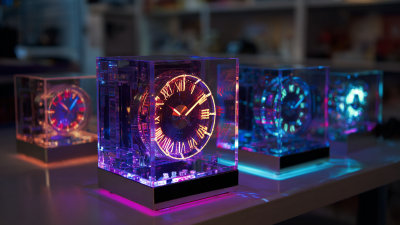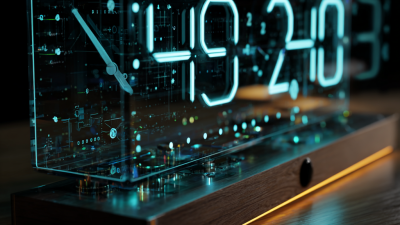In recent years, LED clocks have emerged as a groundbreaking development in the field of timekeeping, transforming how we perceive and interact with time. The global LED clock market has witnessed significant growth, with a projected value expected to reach $1.5 billion by 2025, as highlighted by industry reports. This surge is largely attributed to the increasing demand for energy-efficient and aesthetically appealing timekeeping devices that enhance modern living spaces.
The science behind the brightness of LED clocks not only contributes to their popularity but also underscores their technical superiority. Unlike traditional clocks, LED clocks utilize Light Emitting Diodes (LEDs), which consume considerably less power and boast a longer lifespan. According to a report by the U.S. Department of Energy, replacing conventional lighting with LEDs in various applications can reduce energy consumption by up to 75%. This aspect aligns seamlessly with the growing consumer preference for sustainable and eco-friendly products.
As we delve into the intricacies of LED clocks, we will explore how their advanced technology and design features are redefining timekeeping while offering both functionality and aesthetic appeal. From sleek designs to enhanced visibility, LED clocks are not just time-telling devices; they represent a critical leap forward in timekeeping technology.

The evolution of timekeeping has undergone significant transformations, from traditional analog clocks to the modern LED clocks that dominate today’s landscape. Analog clocks, with their intricate gears and hands, once represented the pinnacle of technology. They not only provided a way to tell time but also served as decorative pieces, boasting craftsmanship and design. However, the limitations of analog mechanisms, including visibility in low light and precision, paved the way for technological advancements.
The introduction of LED clocks marked a pivotal shift in how we perceive and interact with time. Unlike their analog counterparts, LED clocks offer superior brightness and clarity, ensuring that the time is easily readable in various environments, including dimly lit spaces. Moreover, the digital nature of LED technology allows for features such as alarms, timers, and even synchronization with other devices. This shift not only improved functionality but also catered to the fast-paced lifestyle of modern society. As we embrace digital solutions, LED clocks epitomize how innovation can enhance our everyday experiences while redefining our understanding of time.
LED technology has fundamentally transformed the way we perceive and interact with time displays. Unlike traditional clocks that rely on incandescent bulbs or LCD screens, LED clocks utilize light-emitting diodes that produce a vibrant, clear illumination. This technology enhances visibility, allowing time to be read easily in diverse lighting conditions, whether in bright daylight or the dim ambiance of a bedroom at night. The sharp brightness of LEDs not only improves readability but also adds an aesthetic appeal, making modern clocks more than just functional devices—they can be stylish accessories for any space.
Moreover, the efficiency of LED technology plays a significant role in its dominance in timekeeping. LEDs consume significantly less energy compared to their predecessors, ensuring a longer lifespan and reduced electricity costs. This energy efficiency coupled with a lower heat output means that LED clocks are not only environmentally friendly but also safer, minimizing the risk of burns or fire hazards typically associated with older lighting technologies. Overall, the unique properties of LED technology enhance not just the clarity of time display but also contribute to a more sustainable and user-friendly approach to timekeeping.
The brightness levels in LED clocks play a crucial role in enhancing user experience, particularly in various lighting conditions. Research shows that optimal brightness not only helps in readability but also affects mood and productivity. A recent study found that well-lit environments improve focus and reduce eye strain, which is particularly relevant for devices that users frequently check, like clocks. By utilizing advanced technologies for automatic dimming based on ambient light, LED clocks can ensure that users have the best visibility without causing discomfort or distraction.
Furthermore, the rise in popularity of smart devices reinforces the need for customizable brightness settings. Users increasingly prefer devices that adjust their brightness according to the surrounding environment, which can lead to a more tailored experience. For instance, studies indicate that automatic brightness adjustment can enhance the perceived visual quality, making digital displays more appealing. This trend not only marks a technological evolution in timekeeping but also highlights the broader implications of light on human interaction with technology. As lighting solutions become more integrated with user-centric designs, LED clocks are at the forefront, bridging functionality and user satisfaction.
LED clocks are redefining how we perceive time, primarily through their impressive energy efficiency compared to traditional timekeeping devices. Traditional clocks often rely on incandescent bulbs or simple mechanical systems, which can consume more power and have a shorter operational lifespan. In contrast, LED technology utilizes light-emitting diodes that require significantly less energy to produce the same—or even greater—brightness. This shift not only reduces electricity bills but also lessens the environmental impact associated with energy consumption.
Moreover, LED clocks exhibit remarkable durability and longevity. While traditional clocks may require frequent bulb replacements and maintenance, LED systems are designed to last up to 25 times longer. This extended lifespan translates into reduced waste and less frequent need for replacements, making LED clocks a sustainable choice in the long run. As homes and offices increasingly adopt energy-efficient technologies, the benefits of LED clocks become more pronounced, promoting a greener approach to timekeeping without sacrificing style or functionality.
| Feature | LED Clocks | Traditional Clocks |
|---|---|---|
| Brightness Level | Adjustable, up to 1000 lumens | Fixed, typically around 300 lumens |
| Energy Consumption | 5 Watts | 20 Watts |
| Lifespan | Over 50,000 hours | 1,000 - 5,000 hours |
| Cost of Operation (Over 5 years) | $30 | $150 |
| Environmental Impact | Low (recyclable materials) | Higher (toxic materials) |
The design of LED clocks is a fine balance between functionality and aesthetics, offering a sleek, modern look that complements various interior styles. Many manufacturers are focusing on creating designs that not only serve the purpose of telling time but also act as statement pieces in home decor. These clocks come in a variety of shapes, sizes, and colors, enabling users to choose models that resonate with their personal style. The use of minimalist designs paired with vibrant brightness creates an eye-catching focal point, making these clocks not just practical tools but attractive art pieces.
When selecting an LED clock, consider your space and personal taste. Tip: Look for clocks that offer adjustable brightness settings to match your mood and the ambient light in the room. Additionally, consider models with unique features such as weather displays or built-in speakers for added functionality.
Today's design innovations also include smart technology integration. Tip: Opt for LED clocks that can sync with your smartphone or smart home systems for added convenience. This functionality elevates the traditional clock, transforming it into a multifunctional device that enhances both your lifestyle and living space.





